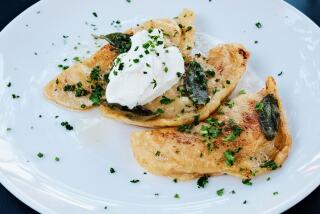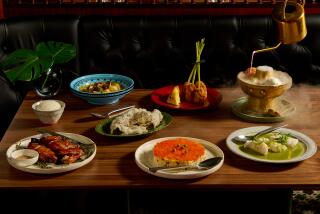Dining Out in Helsinki : Finnish Cuisine Is Created Simply--With Love!
- Share via
HELSINKI, Finland — “There is cow’s blood in this roll,” said our friend, Maija Riihijarvi-Samuel, as she picked up a piece of flat rye bread that strongly resembled Middle Eastern pita.
“In a cold country, it’s important to use everything, and blood gives us iron and vitamins to help us survive the harsh winters.”
We were having dinner in Helsinki’s Finnish Cuisine restaurant, a modern room done in soft blue colors and blond woods that reflected the simplicity and grace of Finnish design.
“For more than 2,000 years Finland has been a marketplace between East and West,” said Riihijarvi-Samuel, who is director of the Martha Organization, a society of Finnish women in home economics.
“Our fur trade was always strong. Back in the days of the old Silk Road we had cultural influences from as far away as Indonesia. So Finnish cuisine is a mixture of influences from the East and the West.”
Riihijarvi-Samuel also pointed out the seasonal nature of Finnish food. Crayfish, for instance, are eagerly anticipated each July, and turbot, a winter-spawning fish, is devoured with delight in January.
The fall hunting season brings such game as hare, venison, reindeer, elk and bear, and in the summer cauliflower, cabbage, onion, potatoes and turnips flourish, along with salmon, whitefish, rainbow trout, herring and more kinds of wild berries than you can count.
The Finnish Cuisine restaurant specializes in presenting traditional dishes from various regions of Finland.
Sauna-cured bear in pastry and egg butter comes from Karelia, a region in the southeast known for its baked goods, and roast snow grouse with rowanberry sauce is from Lapland in the north.
Cold beet-root soup and juniper-flavored reindeer fillets are also served, and for dessert, there’s berry kissel, an 18th-Century dish of stewed, strained berries thickened with potato flour.
A three-course meal costs about 200 Finnish marks (about $53 U.S.) per person, without wine. (The wines served in Finland are mostly French and German, although there are some very pleasant local wines made from currants.)
Western Influence
“The Western influence on Finnish cuisine comes mostly from Sweden, because we were under Swedish rule for 700 years,” Riihijarvi-Samuel told us as we left the restaurant. “And the eastern influence comes largely from Russia--we were a Grand Duchy for about 100 years. Russian cuisine, of course, was heavily influenced by the French.”
With that in mind, we decided to try the newest--and in our opinion, the best--Russian restaurant in town, Alexander Nevski.
The interior evokes an elegant, turn-of-the-century Russian manor house, with floors of glass-like green marble and pillars. Chef Hariton Ivanovits learned cooking from his mother, who moved to Finland from Russia at the time of the Russian Revolution.
We sat at a formal table set with white linen and a gilt candelabrum and sampled braised mushrooms fragrant with sour cream, pepper and spices served in small silver cups.
For the main course we ordered a Ukrainian dish--cabbage rolls stuffed with veal, cucumber, barley and a little garlic, and cooked in a sour cream sauce.
The waitress brought in huge, steaming clay pots crowned with golden clouds of pastry.
She cut open the tops and the aroma of spices and vegetables escaped into the room; it was a fragrance to whet the most jaded appetite.
The taste was equally satisfying, the flavors of the various ingredients melting into the sour cream sauce without losing their individual character. Dessert was a pastry swan filled with cranberry sherbet and decorated with whipped cream.
Russian tea was served in a glass with raspberry jam. Meals at Alexander Nevski cost about 160 Finnish marks (about $45 U.S.) per person, without wine.
The influences of French cuisine are in such restaurants as the Palace Gourmet, on the ninth floor of the Palace Hotel overlooking Helsinki’s harbor.
It’s the first, and so far the only restaurant in Finland to have a Michelin star, which was awarded last year. The room has a comfortable, contemporary feel, and the creations of chef Fero Makela are memorable.
Intensely Flavored
We began with a crayfish bisque, intensely flavored, and served with crusty poppy seed rolls.
Next came a salmon that had been lightly smoked, served over forest mushrooms and in a sabayon sauce with juniper berries. The salmon had a delicate, only slightly smoky taste, and the sauce was light.
Dessert was a bavarois of fresh cheese in a raspberry coulis. The bill came to 230 Finnish marks (about $60 U.S.) per person.
The Swedish influence on Finnish cuisine is evident largely in the popularity of the smorgasbord, that long Swedish buffet table that includes never-ending platters of salted fish, cold salads, smoked meats and a selection of hot casseroles, roasted meats, breads and pastries.
Most of the hotel dining rooms serve a smorgasbord at lunchtime, as do some downtown restaurants, with prices from 25 to 50 Finnish marks (about $6.50 to $13 U.S.).
At a Finnish smorgasbord you’ll find more homemade cheeses than at a Swedish one--more potatoes, more salted and smoked fish, more pastries and infinitely more Baltic herring.
You’ll see herring prepared every way imaginable--in a sour cream sauce, raw with onions, in a sweet marinade. Our favorite was herring in a mustard sauce, spicy but sweet, and ultra-smooth.
Fish in all varieties are a big part of the Finnish diet, and the Kala Rivoli restaurant specializes in seafood and is popular with Helsinki’s artistic community.
The decor is like the inside of a captain’s cabin on an old sailing ship. We sat near a window of leaded glass and began with a cream of mushroom soup with chanterelles, morels, fresh onions and carrots.
Then came an assortment of fresh fish--Baltic herring that had been delicately fried, and grilled whitefish, salmon and pike perch, a freshwater fish that is neither pike nor perch.
A souffle-light vegetable terrine of carrots, cauliflower, squash, spinach and broccoli accompanied the fish. Dessert was marquise au chocolat in a sauce of marzipan cream and topped with tiny bits of mint. The dinner cost 190 Finnish marks (about $50 U.S.) per person.
Wild Game a Staple
Another staple of Finnish cuisine is wild game. Restaurants can buy directly from hunters as long as the game is federally inspected.
The best Finnish-game restaurant we found is in the historic town of Turku on the Baltic Sea. The Brahen Kellari, in the cellar of a 100-year-old building, has brick walls and vaulted ceilings hung with old copper kitchen pots. Owner Altti Holmroos and his wife Ritva offer such specialties as wild venison, rabbit, elk, beaver, ptarmigan and bear.
A smooth, rich terrine of reindeer pate was served with cranberry sauce and was followed by a delicious cream of wild dove soup laced with Madeira.
We were then served a tart but flavorful sorbet made from mesimarja berries--from northern Finland.
The main course was wild badger, marinated in red wine and roasted. It was reminiscent of pot roast, but with a stronger flavor and richer texture. For dessert there was a tart made of pine tree nuts--sweet, with a slight aftertaste of pine.
Our meal cost about 300 Finnish marks (about $79 U.S.) per person, but three-course Finnish game menus are offered for 110 Finnish marks (about $29 U.S.) to 168 Finnish marks (about $44 U.S.).
In Tampere, about a two-hour drive from Helsinki, we found a restaurant specializing in foods made from Finland’s woodland flowers and wild plants.
Ravintola Rapukka is as rustic and cozy as a fairy-tale cottage, and jars filled with spices and herbs from the forest line the walls. We dined on forest mushroom soup, pike perch wrapped in flowering raspberry leaves and served with nasturtium blossoms and fresh dill, and strawberry sorbet topped with tiny wild strawberries--all for about 75 Finnish marks (about $19 U.S.).
One-course lunches are offered for 26 Finnish marks (about $6.80 U.S.). Owner/chef Liisa Asikainen grows many of her own flowers and herbs.
“I live in the woods, where the tonttus live,” she says, speaking of the little elf-like creatures said to inhabit Finland’s forests. “The tonttus give me my recipes.”
While fish, game and wild berries are all important to the Finnish diet, pastries and sweets are vital.
Riihijarvi-Samuel told us that in the old days, in order to get a good husband a young Finnish woman had to able to make seven kinds of little cakes.
Dietary considerations as well as changes in the role of women have altered much of that tradition, but mid-morning or afternoon breaks at small coffeehouses are still popular, and these cafes also make good, inexpensive lunch stops.
Oldest and Best
The oldest and best cafe in Helsinki is Cafe Ekberg. The original was founded in 1861 and was popular among students. In 1915 it was moved to its present site, where a richly carved mahogany exterior marks the cafe and its neighboring bakery.
You sit in cane-backed chairs at old wooden tables topped with granite. You walk to the counter to discuss with the waiter or waitress your selection from the array of pastries, salads and open-faced sandwiches.
Our hot chocolate came with tiny chunks of real chocolate, and a meringue tart was light and not overly sweet. Light lunches cost 18-35 Finnish marks (about $4.75-$9 U.S.) and pastries are 3-8 marks (about 80 cents to $2.10 U.S.).
In contrast, you’ll find a totally modern experience at Cafe Aalto, in a bookstore designed by Finnish architect and designer Alvar Aalto. The cafe is on the third floor of the three-tiered bookstore that has white marble balconies and three-dimensional skylights.
We sat at round, marble-topped tables in sculpted black chairs, also designed by Aalto. The cakes were delicious, and the cream was so rich that it formed tiny pockets of butterfat when poured into the coffee.
Sandwiches and salads cost 18-30 marks (about $4.70-$8 U.S.), and pastries 8-14 marks (about $2.10-$3.70 U.S.).
As we lingered over our coffee and hot chocolate in Alvar’s sleek tribute to Finnish design, we reflected on something else Riihijarvi-Samuel had told us.
“Our food may be simple, but the recipes take time and love. Finnish food may not be as complicated as some other cuisines, but you know it has been made with love.”
Recommended: Alexander Nevski, Pohjoisesplanadi 17; Brahen Kellari, Puolalankatu 1, Turku; Cafe Aalto, Akateemin Kirjakauppa Pohjoisesplanadi; Cafe Ekberg, Bulevardi 9; Finnish Cuisine, Sibeliuksenkatu 2; Kala Rivoli, Rivoli Albertinkatu 38; Palace Gourmet, Etelaranta 10; Ravintola Rapukka, Tammelanpuistok 34, Tampere.
More to Read
Eat your way across L.A.
Get our weekly Tasting Notes newsletter for reviews, news and more.
You may occasionally receive promotional content from the Los Angeles Times.










